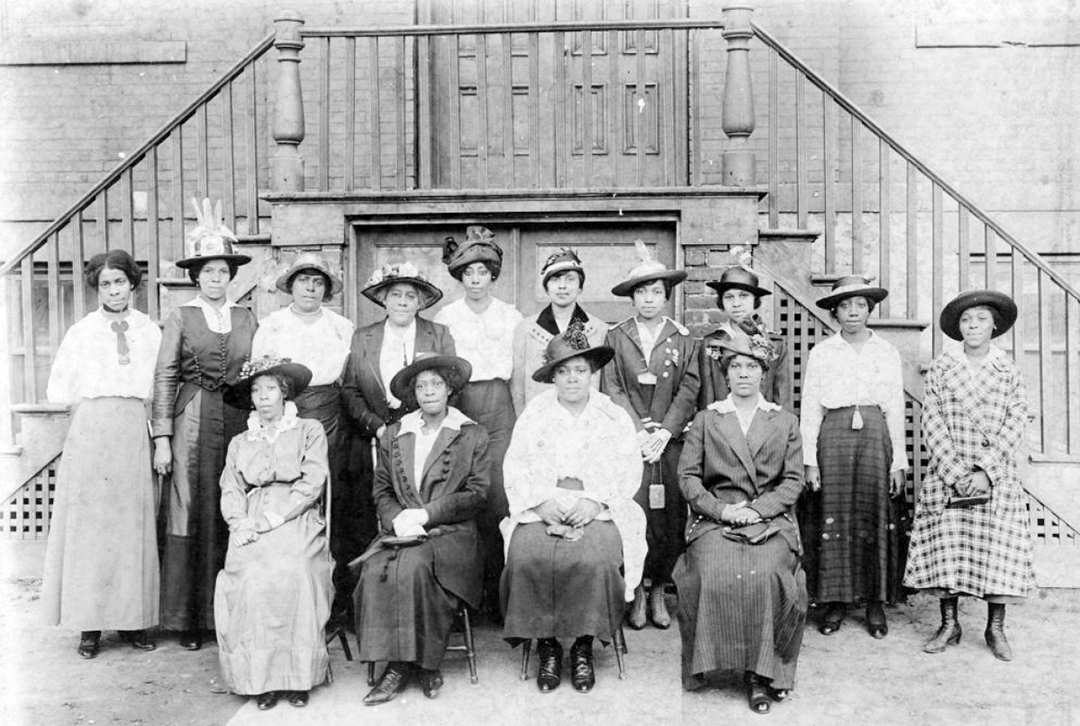Changemakers, a look back at the evolution of women’s clubs over the last century
In recognition of the current year, 2020, the centennial of the ratification of the 19th amendment in 1920, which gave U.S. women the right to vote, we celebrate women’s clubs over the last century and their efforts to keep society moving forward

This article was edited on May 26, 2021 at 2:23pm

The 19th century was a time of great transformation in the United States. A wave of change swept across America. In 1800, the life expectancy for women in the United States was approximately 38 years. By 1816, it increased to almost 44 years, and by 1901, it had jumped to 57 years. So, clearly, something was happening with the lifestyles and nutrition in America. But in those early years, most women didn’t, indeed couldn’t, heed the call. They were exhausted due to their many responsibilities, with no time left over for personal improvement. Life was difficult. Women died in childbirth and often children didn’t live to adulthood. Yet, women had a need to connect, to support one another. They began to come together informally, then more formally over the century. As early as 1847, the Soronian, the first women’s literary society, was founded and it remains exclusively at Olivet College. Two influential women’s clubs, in particular, were formed: Sorosis in 1868 and the New England Women’s Club in the same year. At this early date, the founders of some of these clubs urged women to join and participate in community service. Gamma Phi Beta, established in 1874, appears to be the first women’s group to have been referred to as a sorority, although Pi Beta Phi in 1867 and Kappa Alpha Theta in 1870 functioned as such.
The first African American sorority, Alpha Kappa Alpha, was founded at Howard University in 1908. From the end of the 19th century until well into the 20th century, three separate women’s clubs were formed. The three shared a purpose of improving the conditions of and providing service to the African American population. Importantly, the National Association of Colored Women was established in Wasington, D.C.in 1896. Much has been written about Alpha Kappa Alpha since the nomination of Kamala Harris as vice president, along with Joe Biden as president on the Democratic Party ticket in 2020. As vice-president, Harris is the first woman, first black and first Asian to hold that post. She is black as well as Asian, her mother having been born in India. Harris publicly acknowledged her sorority at Howard University when she accepted the nomination, and interest in the sorority grew when the ticket won the election in November, 2020. Established by nine women who were known as the Original Group of Nine, by 2019 Alpha Kappa Alpha had a membership of over 200,000 women in 950 chapters in the United States. The colors of the Divine Nine are pink and green, and members all over the country went on social media to celebrate the historic inaugural day wearing pink and green, as well as Harris’ trademark pearls and sneakers. A glance at the membership impresses a reader. Without counting many famous women tapped for Honorary membership, those tapped as under graduates include Nobel Prize winning author Toni Morrison, actress Phylicia Rashad, the first African American to win a Tony Award for Lead actress, Bernice King, daughter of Martin Luther King, and Yvonne Brathwaite Burke, Democratic Congresswoman, Los Angeles County Board of Supervisors, and 1972 Democratic National Convention Co-Chairwoman. That made Brathwaite the first African American woman to serve in that position as a member of any important political party.

Leisure class women enjoyed the great luxury of time. As upper class women returned from colleges across the nation in the latter part of the 1800s, they sought to continue learning. They had been exposed to new thoughts, fresh ways of viewing things, and they wanted to continue on that path. Since they were mostly confined to their homes, they arranged to have parlor gatherings for book discussions, musical recitals, and lectures. They also wanted to spend time in one another’s company. Of course, there were many factors that motivated women to connect with one another. Some formed groups to provide needed social services, or to share religious beliefs, or to help one another in practical ways, for instance with farm life. Race definitely bonded women, but until the late 19th century, gatherings of people of color were largely confined to informal arrangements. There was plenty to discuss, but African Americans and Latinas encountered more barriers to making their groups official. They came together to meet, anyway. There was formed a California Federation of Women’s Clubs. Eventually, they found ways, as did many women in the U.S. The saying “a woman’s place is in the home” was the common belief of the time. Women encountered disapproval, but persevered anyway. Leisure class females were notable exceptions, encountering fewer discouragements in pursuing shared interests, though they were still discouraged from meeting outside the home and from participating in advocacy. There were, however, some strong advocates for women’s rights, particularly the right to vote.
The American Association of University Women was officially established in 1881 as the ACA for American women who had attended college. In 1921, the ACA merged with the Southern Association of College Women to the AAUW. It advocates for equity for women and girls, education, and research. Its purpose is clear and it continues to operate in 2020. It has many chapters across the country and meets regularly in social settings. But it, too, in 2020 is seeing a reduction in membership in some areas.

By 1898, there were so many women’s clubs, some incredibly small and others of fair size, that the General Federation of Women’s Clubs published an 1,184-page volume titled The History of the Women’s Club Movement in America. It was written by Jane Cunningham Croly, who was, among other memberships, the Honorary President of Sorosis. While briefly treating women’s gatherings in the United States, there are more than 1,000 groups identified by each state. Collecting the information for the book was a monumental task, and it showed the connections among women on a wide variety of interests and pursuits. Still not allowed to vote, some organizations provided a platform for work toward being recognized as full citizens of the U.S. Some were formed purely for social interaction, and others combined social interaction with learning via guest speakers.

Locally, the San Diego Woman’s Club was formed in 1892, occupying a handsome building on Third Avenue in downtown San Diego. We know Flora Kimball resigned as first vice president of the San Diego Woman’s Club to organize the Tuesday Club in National City. The Kimballs’ extensive home library offered a large reference source for others to use. Papers written on subjects of music, literature, and art were made available for study. The Tuesday Club became the Olivewood Club after Flora’s death in 1898. Quickly moving to the 21st century, Olivewood Gardens has been a location utilized by the San Diego Junior League for its work with children. In 1893, the Wednesday Club was formed as a group to discuss literature and art, but in 1895 it was reformed as a literary club. The same year, Mrs, Alonzo E. Horton was elected president. Mrs. Horton was instrumental in obtaining funds from the Carnegie Foundation for building a much needed new library in downtown San Diego. The Wednesday Club is thriving in 2020, but the San Diego Woman’s Club closed in 2018. If the key to surviving were the matter of legacy, then both would be thriving. While legacy plays a part in survival, it doesn’t completely explain why some affiliations are still doing well and others have closed. The officers of the San Diego Woman’s club recently sold the beautiful building and announced it would use the realized funds to promote scholarships.

In 1894, a small group of La Jolla women met to talk about current affairs and literature. What was known then as the Women’s Literacy Club of La Jolla became a large and prominent group known as the La Jolla Women’s Club. Ellen Browning Scripps played an influential role with this group. The beautiful venue was designed by the famed architect Irving Gill.

The 19th century was an amazing awakening of women to the possibilities of joining one another in friendship and in self betterment. It laid the foundation for the explosion of women’s organizations all over the country. Examples cited here are mere microcosms of the national activity. Remember, meals had to be readied, children needed to be tended to, laundry took time and effort, as did myriad cleaning chores. Families suffered illnesses, and sufficient income was often hard to come by. But women were tired of being ignored and they longed to forge friendships and learn about the world.


The first Junior League was established in New York 1901 by Mary Harriman, who was only 19 years old and a debutante. From an early age, Harriman evidenced a social conscience, so she dedicated the New York City Junior League to the Promotion of Settlement Movements. She called on 80 other young women to work with immigrant children on the Lower East Side of Manhattan. The fact that they were young ladies underscored the “Junior” in Junior League. The young women were charged with improving child health as well as nutrition and literacy. An interesting side note is that Eleanor Roosevelt, a friend of Mary Harriman, joined the Junior League of New York in 1903 and instructed young girls at the College Settlement House in dancing and calisthenics. The second Junior League was formed in Boston, Massachusetts in 1907 and the Brooklyn, New York one formed in 1910. The first League in Canada was the one in Montreal, established in 1912. There are almost 300 Junior Leagues in four countries now. This is a group that has constantly changed, repurposing itself along the way, so that, unlike many women’s clubs in America that have diminished in size and age or closed, it remains strong. The San Diego Junior League’s history began in 1927 and consisted of 20 members. It was named the Junior Committee for San Diego Charities for its first two years, then in 1929 it became the Junior League of San Diego, and a member of The Association of Junior League International, Inc. JLSD is still thriving, having constantly adjusted to the times. Flexibility has been its hallmark. Over the years, programming has been sponsored by JLSD at hospitals, museums, with media, schools, performing arts, domestic violence shelters, and many more sites.

The suffragettes were busy during the lead up to 1919/1920, when the 19th Amendment was passed and then ratified. But there were women’s organizations focused on specific purposes separate from securing the right to vote for women. The ZLAC rowing club was formed in San Diego’s Pacific Beach in 1892, and its specific goal was to promote rowing skills among young women. Over the years, generations of women have enjoyed being on the water and competing in rowing contests. Grandmothers, mothers, and daughters have devoted themselves to this activity. ZLAC was formed in 1892 by three Polhamus sisters, Lena, Agnes, and Caroline, and a best friend, Zulette Lamb. Later that year of 1892, another friend, Florence Roper, joined the other four as a founder.

The Thursday Club, founded in 1921, was created to discuss literature and to be informed about current topics of interest. It provided social interaction and information about various topics. A wonderful thing happened in 1927 when Mr. John Mills deeded to The Thursday Club a large piece of land in Point Loma’s Sunset Cliffs. The beautiful building on this land is known as the “club.” It will celebrate its centennial next year.

The Mission Bay Women’s Club was founded in 1926 and it was formed as a club “devoted to the ideals of community service.” At first, members met at each other’s homes. Eventually, they moved into a cottage. This variety of women’s clubs was established in communities all over the U.S.
Many women’s movements were propelled by the availability of the first “pill” for preventing pregnancy in 1960. Some groups having to do women’s liberation have functioned as formal clubs and organizations and fueled the women’s movement, which gained momentum with its newly experienced freedom. Betty Friedan’s book, The Feminine Mystique, published in 1963 and credited with sparking the second wave of feminism in the U.S., had a huge influence in our country. Of course, the timing was perfect. She was a strong vocal advocate for women’s rights. She and Paula Murray founded the National Organization for Women in 1966, an organization that fought for an Equal Rights Amendment, as well as civil rights, LGBT rights, and reproductive rights. Chapters were established in all states, 550 chapters in all.

A national Latina organization, MANA, traces its birth to 1974, when it began with the name Mexican American Women’s National Association, a title it carried until 1994, when its name was officially changed to MANA. The largest Latina organization in the U.S. the word “mana” is short for the Spanish word “hermana,” or sister. Its activism focus is on, among other areas, Latina leadership development, education, reproductive rights, domestic violence, and immigration. Though this is a politically nonpartisan organization, with multiple ideologies represented in its membership, it is liberal in its activism.

While women built strength in pursuing their legislative agendas through club structure, there continued to be myriad women clubs focused upon other topics, such as gardening, investments, literature, religious faith, visual art, performing arts, quilting, cooking, sewing, birthdays, and travel. There was a specific club available to any woman, according to needs and interests. The 19th century laid the foundation for many women’s clubs and organizations that took hold in the 20th century. In that influential century, all over America, needed funds were raised for worthy causes, women strengthened institutions, did battle with injustices, educated students, and enjoyed one another’s company. By the latter part of the 20th century, however, something was amiss. Fewer women were joining women’s clubs now that so many of them were employed outside the home. At the close of the 20th century, with the rise of the internet and social media, the means for women to affiliate with one another shifted from brick and mortar to technology. Some groups survived, even thrived, but many saw their demise. To be nimble in the new era was key. Those that survived reinvented themselves and their ways of operating. An example is national PEO (Philanthropic Educational Organization), which recently celebrated is sesquicentennial. Religious faith has played a large part in its history, but that element is now being called into question by some members.
The Junior League League had grown to 291 chapters in the United States and abroad by 2019. Among its better known members selected for membership have been cookbook author and chef Julia Child, future First Ladies Eleanor Roosevelt, Betty Ford, Barbara Bush, Laura Bush, actress Katherine Hepburn, and Pulitzer Prize winning author Eudora Welty. Junior League is an international organization dedicated to promoting leadership skills and working on behalf of worthy causes such as supporting programs for foster children. It champions volunteerism.
The 21st century demands a fresh approach and women are responding in different ways. Meetings and fundraisers at clubhouses are being replaced by online chat rooms, texting, crowdsourcing, Zoom, Skype, and Facebook. Technology is replacing the person to person live experience that, in the 19th and 20th centuries, made all the difference. Women are changemakers and they are still finding their way.





Comments